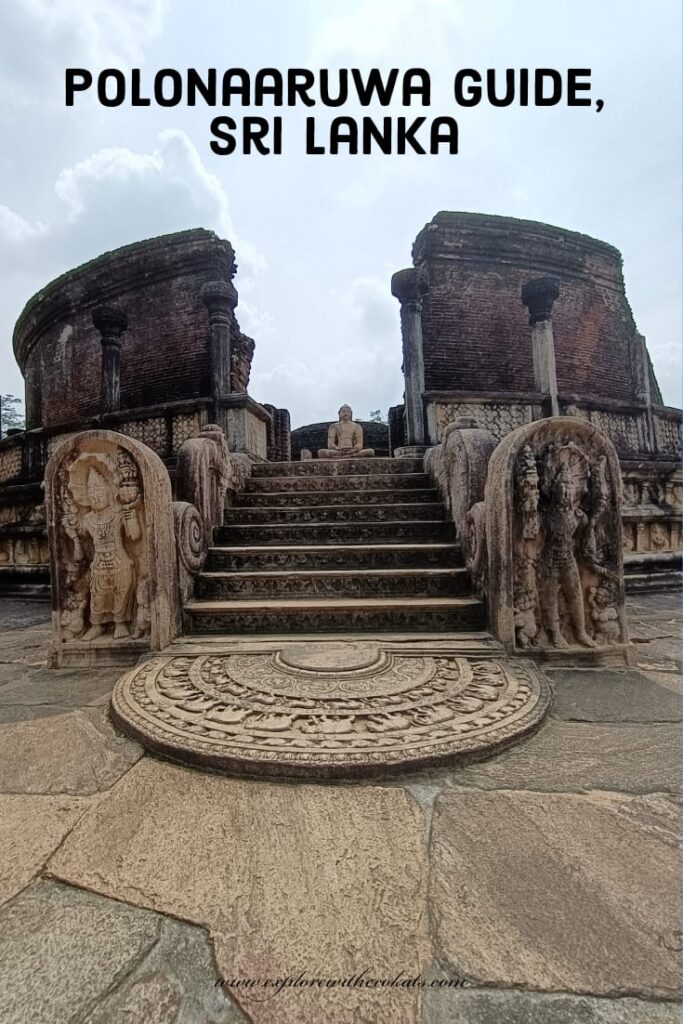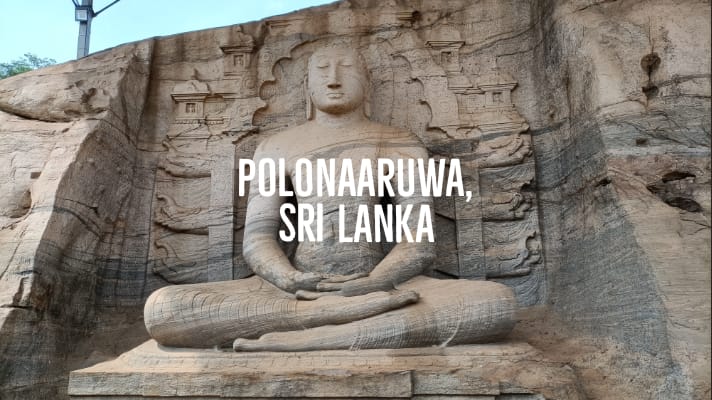Last Updated on May 19, 2023 by
Explore the ancient city of Polonnaruwa in Sri Lanka with this in-depth guide, which includes places to visit in Polonnaruwa, its history, how to get there, and the best time to visit.
Polonnaruwa is one the must visit places in Sri Lanka.
As soon as we arrived at the entrance of Polonnaruwa from Dambulla, I couldn’t help but notice the uncanny resemblance to Angkor Wat, Cambodia. Just the way there are places spilled across Siem Reap, there are many places to visit in Polonnaruwa as well.
Polonnaruwa was the old capital of Sri Lanka and was built between the 10th and 12th centuries. It is now surrounded by an abundance of greenery where the ancient and sacred ruins of Polonnaruwa such as temples, religious buildings, palaces, and water tanks lay still.
In order to cover the ornate details of each ruin in the Polonnaruwa Kingdom it may easily take 2 days. But if you are someone who wants to explore all the Polonnaruwa attractions or highlights, then this guide could be really helpful.
Table of Contents
ABOUT POLONNARUWA
Polonnaruwa is located in the North Central Province of Sri Lanka and is one of the places that form the cultural triangles of Sri Lanka. It is located 220 km from the nation’s capital, Colombo, and around 50 km from Sigiriya.
It has many national parks around it ensuring that it is always green and untouched by civilization.
In 1982, Polonnaruwa was declared one of the 5 UNESCO world heritage sites in Sri Lanka.
POLONNARUWA HISTORY
Polonnaruwa became the capital of Sri Lanka at the end of the 9th century after the first capital, Anuradhapura was invaded and destroyed.
Polonnaruwa was known as “Jananathapuram” and was ruled by the Chola dynasty. After serving as the kingdom of the South Indian Chola Dynasty for three centuries, it was recaptured by the Sinhalese King Vijayabahu I in 1070.
In Vijayabahu’s kingdom, Polonnaruwa became successful and brought prosperity. The next king to rule was Polonnaruwa King Parakramabahu I and under his rule, the city reached its height of power and glory, becoming Sri Lanka’s version of the Gardens of Babylon.
During the rule of King Parakramabahu, a vast irrigation network with reservoirs that resembled natural inland seas were created, leading to extensive rice farming, earning Sri Lanka the nickname “The Granary of the Orient”.
Around the 13th century, Polonnaruwa was abandoned, and the capital shifted to where Colombo is present.
Also Read : One week in Sri Lanka
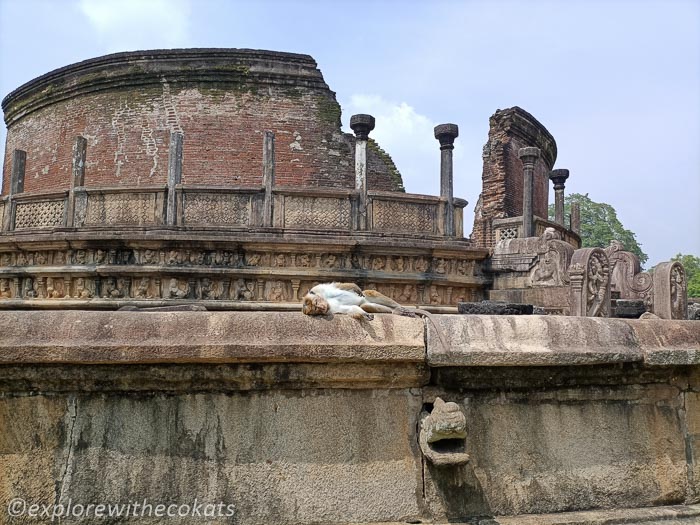
PLACES TO VISIT IN POLONNARUWA
The ruins of Polonnaruwa are full of architectural and archaeological treasures such as stupas, royal palaces, gates, rock-cut caves, monasteries, and temples. This medieval city is a treasure trove and one of the best places to visit in Sri Lanka.
Archaeological museum of Polonnaruwa
The Archeological Museum of Polonnaruwa is the starting point to explore the ancient ruins of Polonnaruwa. This is also where they sell the entry ticket.
The museum in itself is full of exhibits, relics, and artifacts from the bygone era.
A visit to the museum will ensure that visitors have an understanding of the sacred city – how there were different areas dedicated to the fort, the monastery, the kitchen, and other areas.
The Royal Palace of King
The Royal Palace was known as the Vijayotpaya or Vijayanta Prasada. Mahavamsa mentions that this had a thousand chambers.
At seven stories tall, it was believed to be the tallest building in the era. At present, there are remains of three stories.
There are crevices and sockets on the thick brick walls to hold large wooden beams. The massive walls are thicker than one meter, which is probably why it survived the massive fire by invaders.
Around the palace, there are ruins of many buildings and they are identified to be places for rituals and entertainment as well as rooms for palace aides and storage.
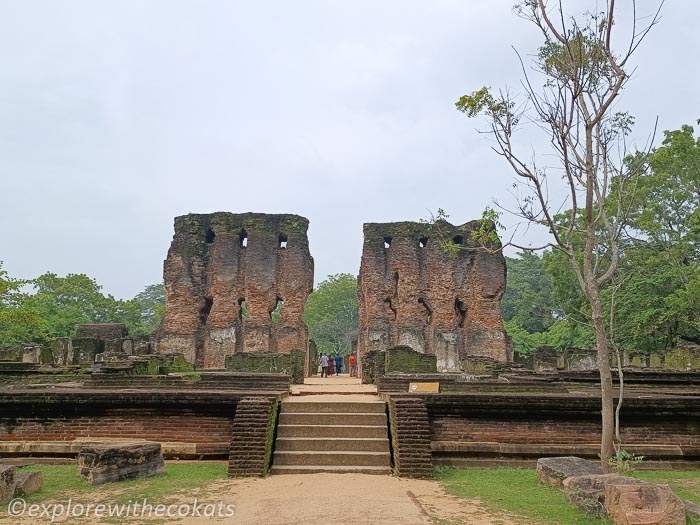
Council Chamber
This is the place where King Parakramabahu used to meet his council members. An inscription found on the stone slab at the upper level of the steps calls this building ‘Raja Vaishyabhujanga Mandapa’.
The chamber’s outer layer has three consecutive tiers with decorated stone tablets/ The bottom layer is carved beautifully with elephants in different postures. The second layer consists of figures of lions, and the top layer has carvings of “Wamana.”
The roof supported on stone pillars of the uppermost tier was probably wooden and had clay tiles. Unfortunately, they have not survived the time.
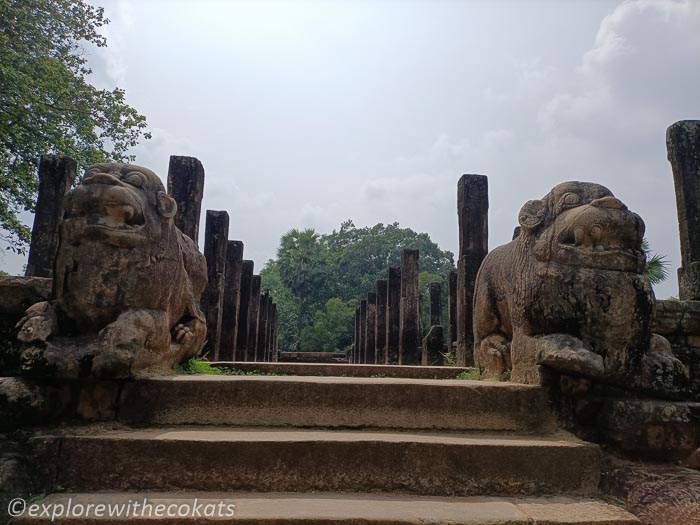
Kumara Pokuna | The Royal Bath
Located right next to the Council Chamber lies the Royal Bath, now known as “Kumara Pokuna.” it was part of a royal private garden.
The pond is elegantly built with a cruciform ground plan in such a way that water from the adjacent watercourse is used to drop through spouts shaped like crocodile mouths. The royal bath is also provided with outlets to drain off used water.
There is also a changing room adjacent to the bath.
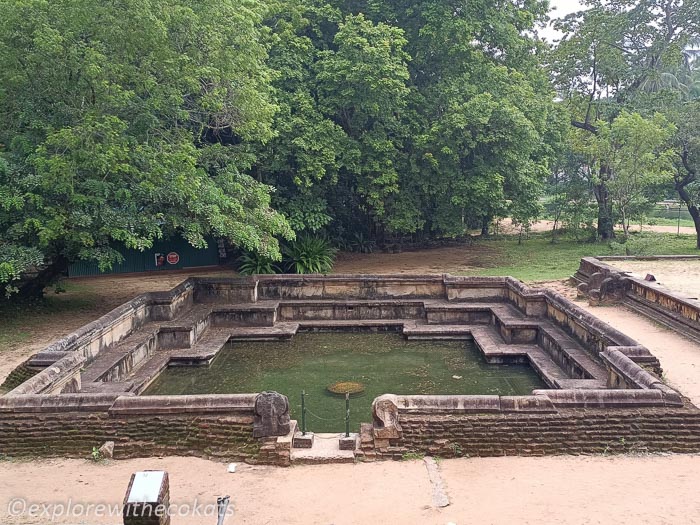
The Sacred Quadrangle
The elevated terrace is known as the Dalada Maluwa or the Sacred Quadrangle. It is one of the best places to visit in Polonnaruwa, as is home to over ten magnificent structures, including the Hetadage, Atadage, Vatadage, Image of Boddhisattwa, Sathmahal Prasadaya, and Thuparama.
This is also the place where the ‘temple of Tooth’ was located before it shifted to Kandy.
As this site offers multiple things to do in Polonnaruwa visitors will be spending a lot of time here. Beware of the monkeys at the entrance!
The Vatadage
Vatadage is one of the most famous monuments in Polonnaruwa, and it is truly a sight to behold. This two-tiered relic house has an unusual design that is built with part brick and part stone.
It is said to have housed the “Scared Tooth Relic of Buddha” before it was moved to the Temple of the Scared Tooth in Kandy where it currently rests.
The Vatadage was constructed to safeguard the stupa at its centre. There are four intricate Buddha statues, all facing different entrances of the stupa.
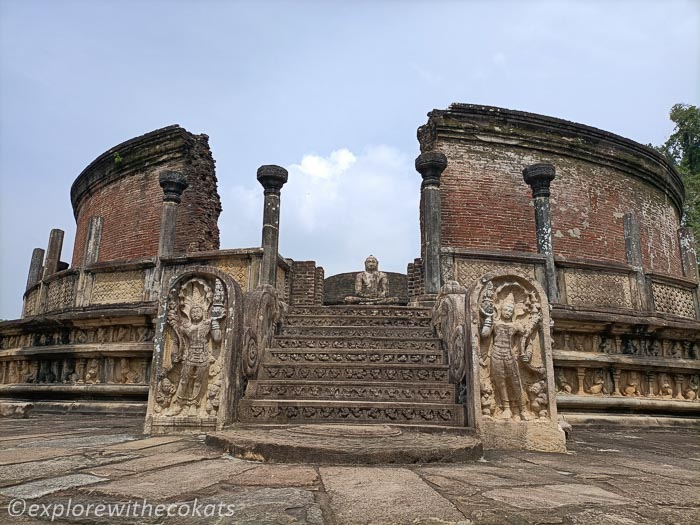
The Hatadage
Hatadage is an ancient shrine that was built by King Nissanka Malla.
Originally, this building seemed to have two stories, but the top floor got destroyed. Inside the temple, there’s a room with three granite Buddha sculptures.
Visitors can also see some remnants of the Hatadage’s brick and stone walls, but the wooden framework has decayed.
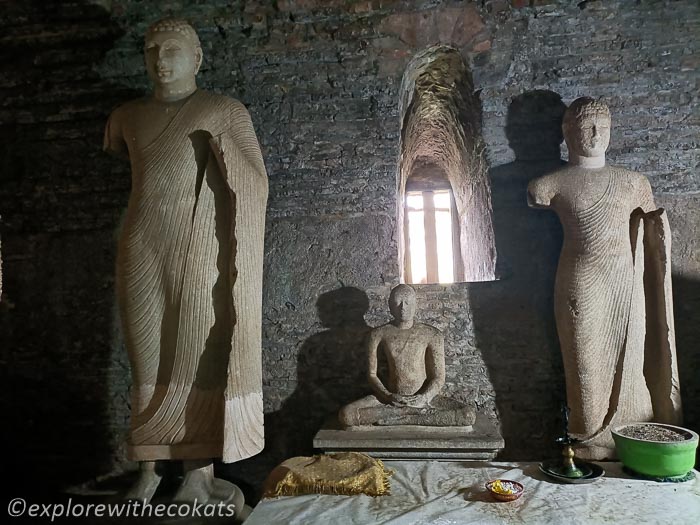
The Atadage
Another attraction that is must see within the Sacred Quadrangle complex is the Atadage. Built by King Vijayanahu I, it is considered the oldest building found in the Sacred Quadrangle.
There’s a granite staircase to get to the second floor of the temple, and initially, there were three Buddha statues, although there’s only one left.
Nissankalata Mandapa
The unusual pillar type indicates a lotus flower in the middle of the mandapa and the pillar is the stalk.
An inscription confirms that King Nissankamalla listened to Pirith – the recital of Buddhist scriptures. In the center of the Mandapa is a small stone-cut stupa having a truncated top. It is said that it was placed to receive the epic casket during Pirith chanting.
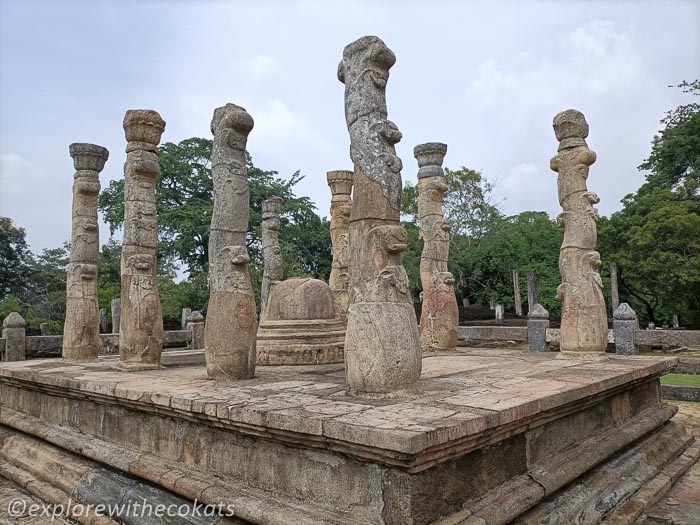
Galpota (Stone Book)
This is a giant inscription on stone done somewhere in the late 11th century. It is said to be the largest stone inscription discovered so far. The letters of the inscription were gilded with molten iron.
This large stone was transported from Mihintale which is over 100 km away from Polonnaruwa. It describes the genealogy of that time and also the heroic tales of King Nissankamalla.
On the side of the stone is the figure of a woman identified as Goddess Gajalakshmi (goddess of prosperity) on whom two elephants are sprinkling water.
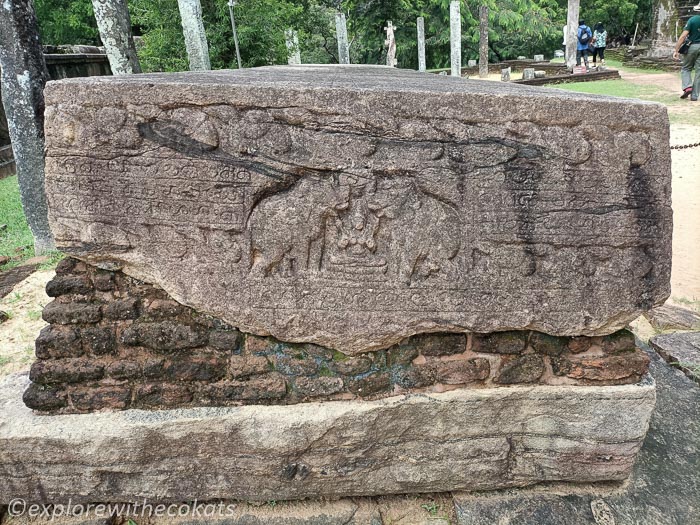
Rankot Vihara
No visit to Polonnaruwa is complete without adding a stop at the Rankot Vihara. With 55 meters in diameter, it is the largest stupa in Polonnaruwa and the fourth largest stupa in Sri Lanka.
Built-in the 12th century during the reign of King Nissankamalla, this stupa is undeniably one of the best places to visit in Polonnaruwa.
The stupa is made entirely out of brick and is extremely well-preserved. Maybe due to its huge structure, it is in excellent condition as compared to others in the area.
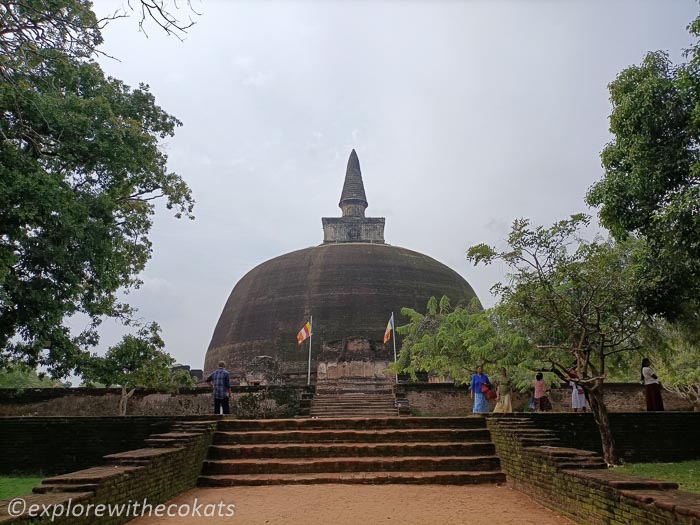
Siva Devalaya
Siva Devalaya is one of the Hindu shrines in Polonnaruwa. Known to be the oldest in the area, it was built by King Rajaraja in the 10th century. According to legends, many images of Hindu gods were discovered on this site.
In the center of the shrine is the stone-cut Shivaling where a Brahmin priest performs puja every day. The scent of the flowers and the melodious rhythms of bells makes one forget that you are in a different country!
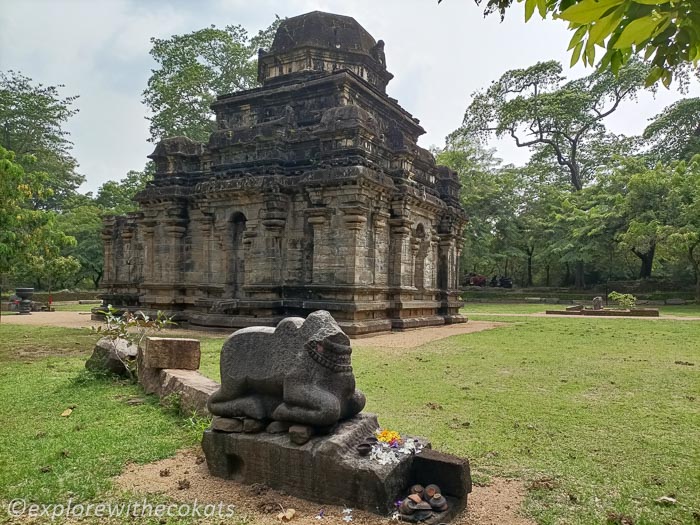
Gal Vihara
The buddha figures of Gal Vihara are one of the highlights of Polonnaruwa from the 12th century. Carved into a large granite gneiss rock, the images are considered to be one of the most well-known rock-cut Buddha statues in Sri Lanka.
Also known as the Rock Monastery, this partially man-made gallery is made up of four enormous rock-cut images, all of which are divine to be in presence of. Each carving showcases a different pose and size – thought to represent a different stage in Buddha’s life.
The standing Buddha is 7 meters tall and is the finest of the series. The reclining Buddha depicted entering parinirvana is 14 meters long. The detail here is amazing, notably the subtle depression in the pillow under the head, and the lotus symbols both on the pillow end and on the soles of Buddha’s feet.
The seated Buddha on the far left has four further Buddhas depicted in the torana (ornamental gateway). The fourth Buddha is in a small rock cavity.
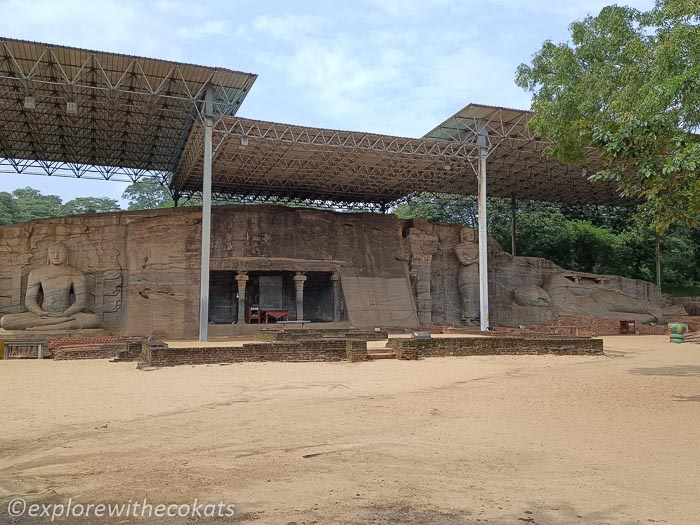
POLONNARUWA ESSENTIAL TRAVEL INFORMATION
Polonnaruwa Entry Fees
The entrance fee for Polonnaruwa is USD 25 per person for foreign visitors. SAARC Foreign nationals get a 50% discount on this fee. This fee doe not include entry to the museum.
This fee may come off as steep, however, if you are an architectural enthusiast or history lover, visiting these heritage sites is worth the price. does include entry to the vast museum complex (more on that below) and the UNESCO World Heritage-listed ruins, so we feel it’s 100% worth it.
Best time to visit Polonnaruwa
Sri Lanka’s best weather to explore Polonnaruwa’s famous places is between December to March. It is dry and pleasant making it perfect for a day’s exploration and loads of walking in the ruins.
How to get to Polonnaruwa
Our visit to Polonnaruwa was via a private car from Dambulla, where we combined half a day of Polonnaruwa Sightseeing and a half day of Minneriya National Park.
If you have a lot of time and want to save on transportation, you can opt for a bus. Buses are available from all major towns of Sri Lanka such as Sigiriya, Dambulla, Colombo, and Kandy.
However, they are time taking and in many cases do not provide direct connectivity. There is also the challenge of getting around all the places to visit in Polonnaruwa.
How to get around Polonnaruwa
Polonnaruwa is spread out over a large area, and it is practically challenging to walk to all the places. Some of the following are great options.
Rent a Bike
It is the best, most cost-effective, and healthy way to explore the Polonnaruwa is to rent a bike. It is a great way to make a pit stop for whatever duration you want and even explore places that are not visited by tourists.
Bikes are available for rent at the entrance to the complex near the museum, or in a town near the bus stop. The cost is approximately 500 LKR per bike per day.
Hire a tuk-tuk
While a bike could be healthy, it still requires effort to paddle. In the right month, it may still be comfortable but tuk-tuk is a better option to cover a maximum ground area in a short time. It offers a great respite against the heat.
The local drivers know the routes and the best places to visit in Polonnaruwa and you just need to sit back and relax.
The cost is approximately 1,500 LKR per tuk-tuk and can easily sit 3 passengers. The duration is 5-6 hours.
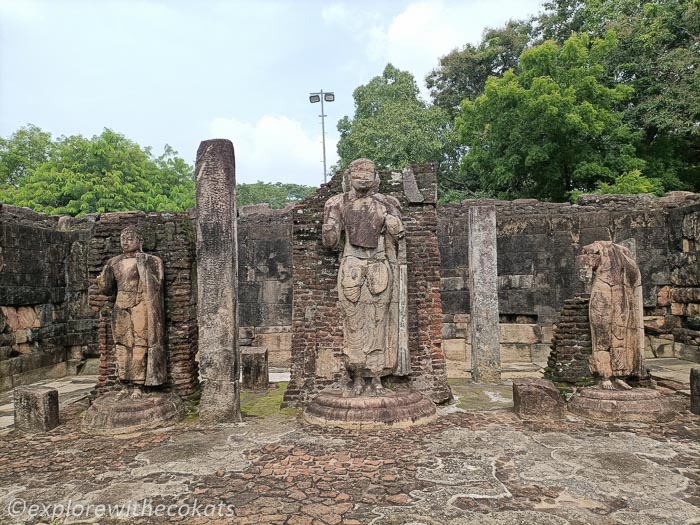
THINGS TO KNOW BEFORE VISITING POLONNARUWA | POLONNARUWA VISIT TIPS
Before visiting the Polonnaruwa ruins, there are a few essential things you need to know:
Hire a Guide at Polonnaruwa
While there are information plates at each site with details, knowing the history, architectural details, and legends from a local guide gives a different perspective on the place.
Also, the way a guide is able to connect all places together in a story will make a lasting impression on your visit. I highly recommend Sri Lanka tourism appointed and approved guide Marcus Fernandes who enthralled us with his plethora of knowledge. He can be reached at +94 777305587.
Take off your footwear and hats
All religious places in Asia require visitors to remove their footwear before entering the main premises. In spite of Polonnaruwa not practicing any worship in most places, visitors are required to remove their footwear because of the presence of idols of Budhha as well as preserve the important relics. Hats and caps are to be removed so as to be respectful.
Wearing socks is allowed and encouraged so as to protect your bare feet in the heat and stones.
Cover your shoulders and knees
Sri Lanka is a conservative country and visitors are required to cover their shoulders and knees before visiting Buddhist sites – especially stupas.
Photos with your back towards Buddha are prohibited
Taking a photo with your back toward the Buddha statue is considered highly offensive. The security at the place will warn you but even if they are not looking, do not pose on purpose.
Be mindful and respectful of the religious practices in the country you are visiting and take a quick look around so that you are not facing the back.
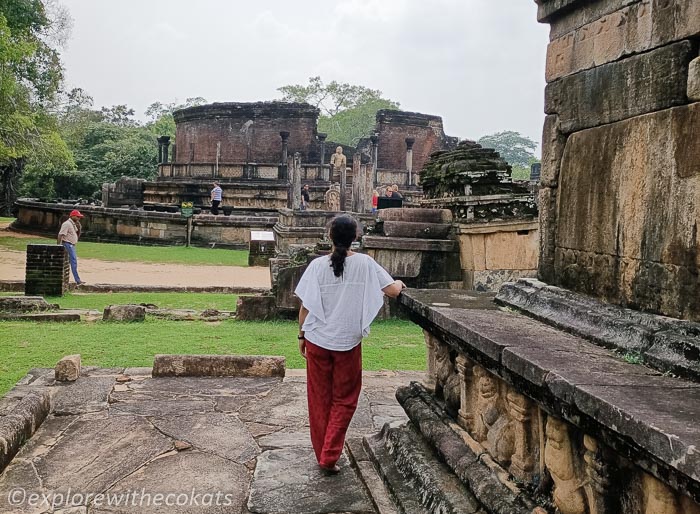
WHERE TO STAY IN POLONNARUWA
There are many options for staying in Polonnaruwa. However, I would suggest staying in Dambulla for the ease of getting to Sigiriya, Anuradhapura, and Polonnaruwa. I stayed at Jetwing lake Dambulla and which is an idyllic property with amazing views.
I also happened to have lunch at Ariya Rest House which is a family-run homestay. The food was one of the best I had during my entire trip to Sri Lanka. I also checked out their rooms and they were clean and cozy. There are various rooms that sleep 2 pax. 3 pax and even 5 pax. Highly recommended! It can be booked here – Ariya Rest House
Hotels in Polonnaruwa: Hotel Sudu Araliya, Mahanuge Hotel Polonnaruwa
Homestays in Polonnaruwa: Senuri Homestay, Malee Homestay
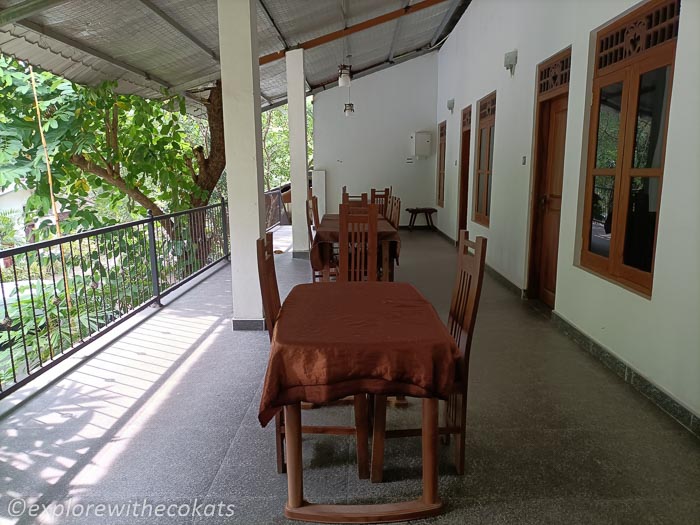
FAQs FOR PLACES TO VISIT IN POLONNARUWA
Why is Polonnaruwa famous?
Polonnaruwa was the second capital of Sri Lanka after the destruction of Anuradhapura in the 10th century. It comprises monuments, stupas, and palaces between the 10th and 12th centuries.
Is Polonnaruwa worth visiting?
Yes! Polonnaruwa has beautiful attractions and significant ancient ruins, making it one of the best places to visit in Sri Lanka.
How long does it take to see Polonnaruwa?
One full day is enough to cover all the Polonnaruwa attractions.
Which is better Anuradhapura or Polonnaruwa?
It is impossible to compare 2 UNESCO Heritage sites! But that being said the monuments in Polonnaruwa are in better shape than Anuradhapura because Polonnaruwa is much younger than its counterpart. At the same time, the number of monuments in Polonnaruwa is far less than the ones in Anuradhapura and sparsely spread.
SUSTAINABLE TIPS FOR PLACES TO VISIT IN POLONNARUWA
- Carry your own refillable water bottle. Thankfully most hotels in Sri Lanka use a glass water bottle for guest rooms so it is easy to fill up your bottle while traveling. Avoid purchasing PET water bottles unless absolutely necessary.
- Do not trash the heritage site with wrappers and uneaten food. Use designated areas and right-colored bins for disposing of waste.
- Be mindful of all the signs and follow them respectfully.
- Do not feed the local monkeys.
Disclosure: I was invited by Destination Sri Lanka to explore the country and visiting Polonnaruwa was part of the itinerary. However, all opinions in this post are unbiased and my own. Special thanks to the team for taking take of everything during this trip.
Disclaimer: This post contains affiliate links. It means it adds no extra cost to you if you book through the link but I get a referral bonus which helps me earn a little to keep this website up and running.
PIN THIS POST!
